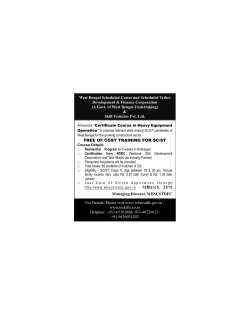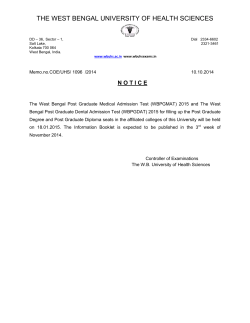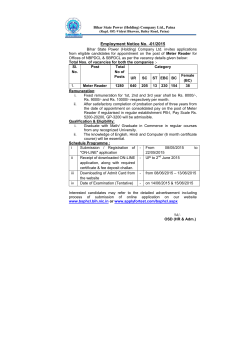
CHAPTER â 3
CHAPTER – III INTERNATIONAL ASPECTS 3.0 Introduction 3.1 The Kosi river The Kosi basin mainly falls in the sub-tropical belt and humid zone. The basin experiences very hot summer and severe winter except in the snow bound area and the hills of Nepal. The monsoon period is from middle of June to middle of October. The winter season is from November to March. Heavy rainfall in Kosi catchment occurs during south-west monsoon period (June to September). There are three IMD observatories in the vicinity of Kosi basin namely Darbhanga, Sabour and Purnea, where monthly and annual values of potential evapotranspiration are worked out from Penman’s formula. Also the potential evapotranspiration of Bhagalpur station in the adjoining basin is considered according to report No.136 IMD (1971). 3.1.1 Countrywise distribution of catchment area Kosi river is an international river. The upper portion of river Kosi flows through Tibet and Nepal in Himalayan Mountains and the lower portion through plains of north Bihar. This river is 468 km long from its origin to outfall in Ganga and has a total catchment area of 93,355 sqkm. The countrywise breakup of the catchment area among Tibet, Nepal and India is as follows: Sl. No. Country Catchment area (sqkm ) 1 Tibet (China) 32671 2 Nepal 39678 3 India (Bihar state) 21006 Total 93355 (Source: History of Kosi Project, WRD, Govt. of Bihar) 3.1.2 Problems of the Kosi river Problems of the Kosi river basin can be categorized as river shifting, heavy sediment load, flooding and water logging and drainage congestion. 34 Further complications arise due to very high rainfall in the catchment in most parts and high seismicity causing landslides and large sediment production which eventually fill up the basin. The Kosi river has laid waste large fertile tracts during frequent migrations and has caused extensive damage through overbank flooding and inundation. Initial suggestions for flood control for the Kosi river during late 19th century included construction of marginal embankments, high dam at upstream section, river training in lower reaches and a series of barrages and canals. However, no consensus was reached and no definitive action could be taken until 1953. A very severe flood in 1953-54 and the subsequent social and political pressure led to the first serious attempts towards flood control in the Kosi basin and the formulation of the Kosi project in 1953. 3.2 International agreement on Kosi project Considering the needs of short term measures that were immediately required for the alleviation of the sufferings of the people of Kosi valley and for prevention of large scale devastation of crops during floods., The then His Majesty's Government of Nepal and the Government of India signed an agreement on 25th April 1954 for implementation of Kosi Project, 1953. The copy of the agreement is given in Annexure 3.1. As per the agreement, the Govt. of India was authorized for the construction, operation and maintenance of the following: i) A barrage across river Kosi, located about 5 km upstream of Hanuman Nagar town. ii) Canal head works at barrage iii) Afflux bund embankment and canal system in the territory of His Majesty's Government of Nepal. iv) Establishing hydro power generating stations at canal. The above agreement was further revised in 1966. The copy of the revised agreement is also given in Annexure 3.1. 3.3 The Mahananda sub-basin The river Mahananda is one of the major northern tributary of the river Ganga, passing through Nepal, India and Bangladesh. It is bounded on the North by the Himalayas, the ridges separating it from the Teesta river 35 system in the East, the Ganga on the South and the Kosi river system in the West. It is spread over districts of Purnea, Kishanganj, Araria and Katihar in Bihar and Malda, West Dinajpur and Darjeeling in West Bengal. It drains a total catchment area of 23,700 sqkm over a length of 137 km. The hilly catchment in Nepal pertains to tributaries of the Mahananda river namely Parman, Bakra, Eastern Kankai, Western Kankai and the Mechi, while that of the main river Mahananda lies in the Darjeeling district of West Bengal. 3.3.1 Mechi sub-basin The river Mechi is a major western tributary of Mahananda. The river Mechi a perennial river which rises in the inner valley of the Himalaya in Mahabharat range of hills in Nepal near Sindhuliagarhi at an elevation of 2,423 m at the Latitude 260 50′ N and Longitude 880 7′E 3.4 Interstate agreement between State Governments of Bihar and West Bengal The State Governments of West Bengal and Bihar desirous of achieving the optimum utilization of the water resources of Mahananda river basin and recognising the desirability for fixing and delimiting the rights and obligations of each state in relation to the other concerning the use of these waters, have reached an agreement on 19 th July, 1978. Two barrages have been proposed on Mahananda river for providing irrigation as given below: In the Teesta project, West Bengal has finalized location of Mahananda barrage at Fulbari. From this barrage Bihar can draw water for irrigating approximately 67,000 acres in Bihar depending on the Mahananda resources only. Off-takes may be taken from the West Bengal canal system if this is economical and reduces land acquisition. Until such time that the Mahananda waters become usable in Bihar or diversion from Teesta is made available, West Bengal will be permitted to draw water from Mahananda through this barrage. A joint irrigation project from Bagdob barrage may also be taken up for irrigating areas in Purnea district in Bihar and in Malda district in West Bengal depending upon the available resources of Mahananda basin in a manner to be mutually agreed upon between the two states. This barrage is envisaged also for regulating the flows of Mahananda into its two branches, 36 the Phulahar and the Barsoi. West Bengal may divert a part of their Teesta resources for supplementing irrigation in areas in West Bengal if necessary. The cost of the Mahananda barrage at Fulbari will be shared between Bihar and West Bengal in the proportion of the irrigation areas in the respective states. The cost of the head regulators and cross regulators will be borne by the respective states. Similarly the cost of Bagdob barrage including irrigation system shall be apportioned according to uses in the respective states. The agreement signed between Govt. of Bihar and Govt. of West Bengal is given in Annexure 3.2. 3.5 Impact of water diversion on international/interstate water sharing agreements 3.5.1 Impact of Kosi-Mechi intra-state link on bilateral agreement on Mahananda water The Kosi-Mechi Intra-State link envisages diversion of Kosi water for extending irrigation in un-irrigated areas of Mahananda basin lying between river Parman and Mechi by utilizing the existing Eastern Kosi Main Canal after its remodeling beyond river Parman and upto river Mechi for providing irrigation in new command areas lying in Araria, Kishanganj, Purnea and Katihar districts of Bihar. Since, the Kosi-Mechi intra state link is not utilizing any waters from Mahananda basin, hence the bilateral agreement signed between Govt. of West Bengal and Govt. of Bihar will not be affected. 3.5.2 Indo-Bangladesh agreement on Ganga water The river Kosi is a tributary of river Ganga. There is an agreement between Govt. of India and Govt. of Bangladesh on Ganga water sharing and to maintain a minimum flow in Ganga at Farakka in lean season. The water diversion from Kosi barrage (Hanuman Nagar barrage) to Mechi river is viewed in the light of Indo-Bangla agreement on Ganga water sharing. Since the diversion of Kosi water through Kosi – Mechi intra state link canal is proposed only in kharif season, therefore the Indo-Bangla treaty will not be affected. The agreement signed between Government of India and Bangladesh is given in Annexure 3.3. 37
© Copyright 2025









